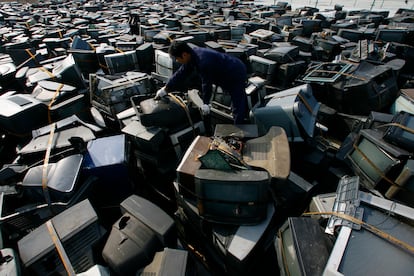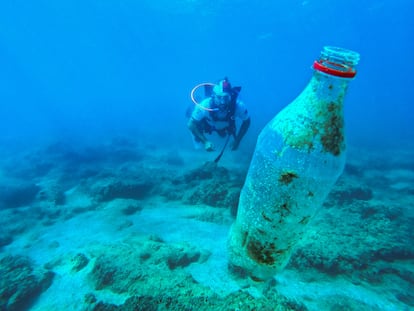What should you do with your electronic waste?
Approximately 50 million tons of e-waste are discarded each year worldwide, only 5% of which is recycled

Can you imagine having gold and throwing it away? Well, this happens more often than you might think. For example, with those electrical or electronic devices that stopped working or that we no longer use. These artifacts are generally made of plastics as well as metals such as aluminum, copper and, yes, gold.
We live in an era of consuming and discarding, and when we are done using these devices, instead of looking for a new way to put them to use or recycling them, we just throw them away. The infamous planned obsolescence, paired with the obsession with always having the latest model of everything, only make things worse.
The Global E-waste Monitor (GEM) estimates that the most discarded devices are cell phones, hard drives, CPUs, monitors, modems, printers, cables and televisions. This can be dangerous: the composition of these devices is 72% recyclable materials, 25% reusable materials and 3% hazardous waste (cathode-ray tubes, integrated circuit boards, refrigeration gases, PCBs). Their accumulation, the GEM explains, affects human health through exposure to toxic elements such as lead.
The GEM also describes adverse health effects ranging from birth problems, neurological development disorders, learning disabilities, DNA damage, cardiovascular and respiratory problems and skin diseases, among others, as well as soil, water and air pollution.
For its part, the International Labor Organization (ILO) states that these residues make up the fastest-growing waste stream in the world, and explains that they require special treatment as they contain dangerous elements. The complexity and cost of recycling them creates an urgent need for an adequate regulatory framework, as they constitute an important problem for the environment and the health of the population.
World ranking
According to the the Eco House organization, approximately 50 million tons of electronic waste is discarded every year worldwide. Among the countries most affected by these residues, where they receive more than they produce, are Ethiopia, Ghana, India, Singapore, and Malaysia. The ILO reveals that the countries that generate the most waste from electrical and electronic equipment (also known as WEEE) are Brazil (35%), Mexico (20%), Colombia (8%) and Argentina (7%).
If the generation of WEEE is analyzed in terms relative to population, the largest producers are Chile (21.8 pounds per inhabitant) and Uruguay (20.9 pounds per inhabitant). However, these levels are moderate when compared to countries like the United States or Italy (48.5 and 39.2 pounds per inhabitant per year, respectively.)
Other data comes from the report “Technology for climate action in Latin America,” by the GSMA Association and the Inter-American Development Bank (IDB), published in June 2018. In it, Uruguay appears as the country with the highest generation of electronic waste per person, with an average of 24.2 pounds per person annually.
The country with the lowest generation per person is Nicaragua, with an average of 4.4 pounds. “The regional average reached around 15.4 pounds per person per year, close to the world average (estimated at 13.2), but considerably lower than that of Europe (35.3 pounds),” explains the document. “These Latin American figures are possibly due to the practice of reusing electronics. In the region, reused devices are often given away or sold, increasing their useful life.”
A new life
Even if we no longer have any use for the things we use on a daily basis, it does not mean that their useful life has ended. On the contrary, not only are there many undertakings and projects that can still use them, but also, by recycling them, we are doing a good deed for the planet.
The Global E-waste Monitor states that only 5% of all WEEE is recovered or recycled. In general, 50% of all unused cell phones are stored in homes and institutions due to a lack of knowledge about what to do with them. So what can we do from where we stand?
· Purchase electrical and electronic products that prioritize the recycling of certain parts.
· Try to maximize the lifespan of your devices.
· Avoid changing them if they still work, or fix them if you can.
· What you do discard, take it to organizations, foundations or programs that will renovate or recycle them.
What can you recycle?
· Computers, notebooks, monitors, keyboards, mice.
· Decoders, modems.
· Printers.
· Landline phones, cell phones.
· Fax machines, stereos, VHS players, DVD players and televisions, among others.
The art of recycling
Some organizations look for alternative, creative ways to deal with this issue. A good example can be found in Buenos Aires, Argentina, where there is a place where WEEE becomes art: Esquinazo Recicla, a civil association that recycles electronic waste. They take anything, from an earphone to a refrigerator. There, the board from a CPU or LED TV can end up becoming anything, from a Mona Lisa to a Darth Vader.
“We carry out a chain of favors with the equipment we recover. For example, we donate recovered computers to social spaces,” says Mariano Moreyra, founder of Esquinazo Recicla.
It is estimated that this is the kind of waste that will increase the most in the future, as a consequence of technological advances. For this reason, every time you are done using a cell phone, a computer or even a refrigerator, what is worth gold is knowing the right way to dispose of it, in order to promote the circular economy and a better future for our planet.
Sign up for our weekly newsletter to get more English-language news coverage from EL PAÍS USA Edition
Tu suscripción se está usando en otro dispositivo
¿Quieres añadir otro usuario a tu suscripción?
Si continúas leyendo en este dispositivo, no se podrá leer en el otro.
FlechaTu suscripción se está usando en otro dispositivo y solo puedes acceder a EL PAÍS desde un dispositivo a la vez.
Si quieres compartir tu cuenta, cambia tu suscripción a la modalidad Premium, así podrás añadir otro usuario. Cada uno accederá con su propia cuenta de email, lo que os permitirá personalizar vuestra experiencia en EL PAÍS.
¿Tienes una suscripción de empresa? Accede aquí para contratar más cuentas.
En el caso de no saber quién está usando tu cuenta, te recomendamos cambiar tu contraseña aquí.
Si decides continuar compartiendo tu cuenta, este mensaje se mostrará en tu dispositivo y en el de la otra persona que está usando tu cuenta de forma indefinida, afectando a tu experiencia de lectura. Puedes consultar aquí los términos y condiciones de la suscripción digital.










































